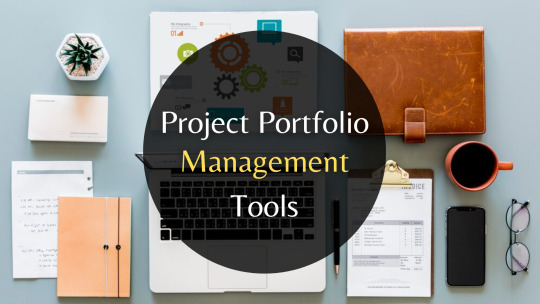#Project Portfolio Management
Explore tagged Tumblr posts
Text
Top Trends Shaping the Future of Project Portfolio Management
The global project portfolio management (PPM) market is poised for significant growth, with projections indicating an increase from USD 5,303.6 million in 2024 to USD 7,911.0 million by 2030, reflecting a compound annual growth rate (CAGR) of 6.9% during this period. Key Market Drivers: Comprehensive Project Oversight: Organizations are increasingly seeking 360-degree visibility into project…

View On WordPress
0 notes
Text

Simplify project planning and execution with Innovation Minds’ project management suite. Leverage tools designed to support collaboration, track progress, and meet deadlines effortlessly. Empower your team to excel—discover the power of Innovation Minds today and start driving results!
#project portfolio management#project management platforms#project portfolio management tools#project management suite
0 notes
Text

Unlock significant cost savings with effective project portfolio management. Investing in proven practices guided by project management consulting services can optimise resource allocation, reduce waste, and enhance outcomes—leading to lower costs and improved team communication, product quality, and customer satisfaction.
0 notes
Text
Maximize Efficiency with Leading PPM Software Solutions

In today’s fast-paced business environment, efficiency is not just a goal; it’s a necessity. Project Portfolio Management (PPM) software solutions have become indispensable tools for organizations aiming to streamline operations, optimize resources, and enhance productivity. By integrating PPM software into your business processes, you can significantly boost efficiency and drive better project outcomes. Here’s how leading PPM software solutions can help you achieve these goals.
Centralized Project Oversight
PPM software provides a centralized platform for managing multiple projects simultaneously. Tools like Microsoft Project, Planview, and Smartsheet offer comprehensive dashboards that give managers real-time insights into project statuses, timelines, and resource allocation. This centralized oversight ensures that all projects are aligned with strategic objectives and are progressing as planned.
Optimal Resource Allocation
Effective resource management is crucial for maximizing efficiency. PPM software like Wrike and Monday.com excels in resource allocation by offering tools to plan, track, and optimize the use of resources across projects. These platforms help ensure that the right resources are assigned to the right tasks at the right time, preventing overallocation and underutilization.
Enhanced Collaboration
Collaboration is key to efficient project execution. Leading PPM software solutions provide integrated communication tools that facilitate seamless collaboration among team members. Platforms such as Asana and Trello offer features like shared dashboards, document management, and real-time chat, ensuring that all team members are on the same page and can easily share information and updates.
Data-Driven Decisions
PPM software empowers organizations to make data-driven decisions by providing robust analytics and reporting features. Tools like Tableau and Microsoft Power BI integrate with PPM solutions to deliver actionable insights into project performance. Managers can use these insights to identify trends, forecast future performance, and make informed decisions that enhance efficiency.
Risk Management
Every project comes with inherent risks. PPM software like Clarizen and Planview helps identify, assess, and mitigate these risks, ensuring that projects stay on track. By proactively managing risks, businesses can avoid potential disruptions and ensure smooth project execution.
Conclusion
Maximizing efficiency in project management is essential for staying competitive in today’s business landscape. Leading PPM software solutions offer the tools needed to centralize project oversight, optimize resource allocation, enhance collaboration, enable data-driven decisions, and manage risks effectively. By integrating these solutions into your operations, you can drive better project outcomes, boost productivity, and achieve your strategic goals more efficiently. Embrace PPM software to transform your business operations and stay ahead in the competitive market.
0 notes
Text
Unleashing Success with Project Portfolio Management: A Comprehensive Guide
https://ciolookleaders.com/wp-content/uploads/2024/05/1-Unleashing-Success-with-Project-Portfolio-Management_-A-Comprehensive-Guide.jpg
In today’s dynamic business landscape, organizations are constantly striving to stay ahead of the curve. With a plethora of projects in the pipeline, managing them efficiently becomes paramount. This is where Project Portfolio Management (PPM) steps in as a game-changer. In this comprehensive guide, we delve into the intricacies of PPM, its significance, and how it can empower organizations to achieve their strategic objectives seamlessly.
Understanding Project Portfolio Management
Project Portfolio Management, often abbreviated as PPM, is a strategic approach that enables organizations to effectively manage and prioritize a portfolio of projects to achieve their business objectives. It involves the centralized management of projects, programs, and other initiatives to align with the organization’s goals and objectives.
At its core, PPM focuses on optimizing resource allocation, mitigating risks, and maximizing returns on investment (ROI) across the entire project portfolio. By employing PPM practices, organizations can make informed decisions, allocate resources judiciously, and ensure that projects are aligned with the overarching business strategy.
Key Components of Project Portfolio Management
1. Portfolio Governance

Governance plays a pivotal role in PPM by establishing policies, processes, and procedures for decision-making and oversight. It involves defining roles and responsibilities, establishing clear communication channels, and ensuring transparency throughout the project lifecycle.
2. Strategic Alignment
PPM aims to align projects with the organization’s strategic objectives to ensure that resources are allocated to initiatives that contribute the most value. By prioritizing projects based on their alignment with strategic goals, organizations can focus their efforts on initiatives that drive business growth and competitive advantage.
3. Resource Management
Effective resource management is essential for optimizing resource utilization and avoiding overallocation or underutilization of resources. PPM provides visibility into resource availability, skills, and capacity, allowing organizations to allocate resources efficiently and avoid bottlenecks.
4. Risk Management
Risk management is integral to PPM as it helps identify, assess, and mitigate risks associated with projects. By proactively addressing potential risks, organizations can minimize disruptions and enhance the likelihood of project success.
5. Performance Measurement
PPM involves tracking and evaluating the performance of projects against predefined metrics and KPIs. By monitoring key performance indicators, organizations can identify areas for improvement, make data-driven decisions, and ensure that projects are delivering the intended outcomes.
6. Communication Management
Effective communication is vital for the success of PPM initiatives. Establishing clear communication channels among stakeholders ensures that everyone is informed about project status, changes, and important decisions. Regular communication fosters collaboration, alignment, and transparency throughout the project lifecycle.
The Benefits of Project Portfolio Management
Implementing Project Portfolio Management offers a myriad of benefits to organizations across industries:
1. Improved Decision-Making
PPM provides stakeholders with actionable insights and data-driven analytics to make informed decisions about project selection, prioritization, and resource allocation.
2. Enhanced Resource Utilization
By centralizing resource management, PPM enables organizations to optimize resource allocation, improve productivity, and reduce costs.
3. Alignment with Strategic Goals

PPM ensures that projects are aligned with the organization’s strategic objectives, allowing businesses to focus their efforts on initiatives that drive long-term growth and success.
4. Reduced Risk
Through proactive risk management practices, PPM helps organizations identify and mitigate risks early in the project lifecycle, minimizing potential disruptions and ensuring project success.
5. Increased ROI
By prioritizing projects based on their potential return on investment, PPM helps organizations maximize the value generated from their project portfolio, resulting in increased ROI.
6. Stakeholder Engagement
PPM promotes stakeholder engagement by involving key stakeholders in the decision-making process and keeping them informed about project progress and outcomes. Engaged stakeholders provide valuable insights, support, and buy-in, which enhances project success and fosters a culture of collaboration and accountability.
Best Practices for Implementing Project Portfolio Management
While the benefits of PPM are undeniable, successful implementation requires careful planning and execution. Here are some best practices to consider:
1. Define Clear Objectives
Clearly define the objectives and goals of your PPM initiative, ensuring alignment with the organization’s overall strategy and priorities.
2. Establish Governance Structure
Develop a robust governance structure with clearly defined roles, responsibilities, and decision-making processes to ensure accountability and transparency.
3. Prioritize Projects
Use criteria such as strategic alignment, resource requirements, and potential ROI to prioritize projects and allocate resources effectively.
4. Implement Robust Risk Management

Identify potential risks associated with projects and develop mitigation strategies to address them proactively.
5. Monitor and Evaluate Performance
Continuously monitor and evaluate the performance of projects against predefined metrics and KPIs to identify areas for improvement and make data-driven decisions.
6. Continuous Improvement
PPM is an iterative process that requires continuous improvement and refinement. Regularly review and evaluate the effectiveness of your PPM practices, identify areas for enhancement, and implement changes to optimize performance and drive continuous improvement. Embrace a culture of learning and adaptability to stay ahead in today’s rapidly evolving business landscape
Conclusion
In conclusion, Project Portfolio Management is a strategic approach that enables organizations to effectively manage and prioritize a portfolio of projects to achieve their business objectives. By aligning projects with strategic goals, optimizing resource allocation, and mitigating risks, PPM empowers organizations to drive growth, innovation, and competitive advantage.
As businesses continue to navigate complex and ever-changing market dynamics, the adoption of Project Portfolio Management is becoming increasingly crucial. By embracing PPM best practices and leveraging advanced tools and technologies, organizations can unleash the full potential of their project portfolio and pave the way for sustained success in the digital age.
Project Portfolio Management isn’t just about managing projects; it’s about transforming the way organizations operate, innovate, and thrive in today’s fast-paced business environment. Embrace the power of PPM and unlock new opportunities for growth, efficiency, and excellence in project management.
Also Read: Unlocking the Potential of Management Leadership for Tomorrow
0 notes
Text
Supercharge Your Portfolio: The Ultimate Guide To Project Portfolio Management Tools

The need for effective oversight and strategic alignment is paramount. Enter Project Portfolio Management tools (PPM) —a transformative arsenal designed to empower organizations in their quest for project success. These tools, equipped with advanced capabilities and robust features, serve as the compass guiding businesses through the complexities of project portfolios, enabling informed decision-making, resource optimization, and strategic alignment with overarching objectives.
As organizations grapple with an ever-expanding array of projects, varying in scope, scale, and strategic importance, the need for effective portfolio management has never been more pronounced. PPM tools offer a holistic approach to portfolio oversight, enabling stakeholders to gain visibility into project lifecycles, track performance metrics, and make data-driven decisions that drive project success and organizational growth.
Moreover, in an era defined by digital transformation and rapid technological advancement, the capabilities of PPM tools continue to evolve, ushering in a new era of efficiency and innovation. From predictive analytics and AI-driven insights to seamless integration with existing workflows and collaboration platforms, these tools empower organizations to adapt to change, seize opportunities, and stay ahead of the curve in an increasingly competitive landscape.
What Is Project Portfolio Management?
Project Portfolio Management (PPM) is a strategic approach used by organizations to effectively manage and prioritize a collection of projects or initiatives in alignment with their overall business objectives and constraints. Essentially, PPM involves making decisions about which projects to pursue, how to allocate resources across those projects, and how to monitor and control the portfolio to ensure that it delivers the desired outcomes.
At its core, PPM aims to optimize the organization's investment in projects by selecting and executing the right mix of projects that best support its strategic goals and deliver the highest value. This involves evaluating potential projects based on factors such as their alignment with business objectives, potential return on investment (ROI), resource requirements, risks, and dependencies.
Process Of Portfolio Management
Initiation And Planning
The portfolio management process begins with identifying the organization's strategic objectives and goals. This involves understanding the organization's mission, vision, and long-term strategy.
The current portfolio is assessed to determine its alignment with the organization's objectives, as well as its overall health and performance. This involves analyzing factors such as project status, resource utilization, risks, and returns.
Selection And Prioritization
Potential projects are identified that align with the portfolio strategy and contribute to the organization's objectives. This may involve generating project ideas, soliciting proposals, or evaluating existing project requests.
Each potential project is evaluated based on criteria such as strategic alignment, potential benefits, resource requirements, risks, and dependencies. Projects are then prioritized according to their perceived value and contribution to the portfolio's objectives.
Execution And Monitoring

Once projects are selected and prioritized, resources such as budget, personnel, and equipment are allocated to support their execution. Resource allocation decisions are guided by the portfolio strategy and priorities.
Project performance is monitored throughout the execution phase to ensure that projects are progressing according to plan. Key performance indicators (KPIs) are tracked, and deviations from the plan are identified and addressed in a timely manner.
Review And Adaptation
Regular reviews of the portfolio are conducted to assess performance against objectives and KPIs. This involves analyzing project outcomes, identifying lessons learned, and evaluating the overall effectiveness of the portfolio strategy.
Based on the performance review and changing business conditions, adjustments may be made to the portfolio strategy. This may involve reallocating resources, reprioritizing projects, or adding/removing projects from the portfolio to better align with organizational objectives.
Is Using Portfolio Management Software Worth It For Business?
Using portfolio management software can indeed be highly beneficial for businesses, offering a range of advantages that make it well worth the investment. Firstly, such monitoring software provides organizations with a centralized platform for managing their project portfolios, enabling them to streamline processes, enhance visibility, and improve decision-making.
By consolidating project data, resources, and performance metrics in one place, portfolio management software empowers stakeholders to gain real-time insights into the health and progress of their portfolios, facilitating proactive adjustments and optimizations as needed.
Moreover, portfolio management software often comes equipped with advanced analytics and reporting capabilities, allowing organizations to analyze trends, identify patterns, and extract valuable insights from their portfolio data. This enables informed decision-making, risk management, and resource allocation, ultimately driving better project outcomes and organizational performance. Also Watch: Leading Employee Engagement and Workforce Productivity Tool
youtube
Final Words!
As we draw this journey to a close, it becomes evident that in today's complex business landscape, where organizations juggle myriad projects, initiatives, and priorities, the need for effective portfolio management has never been greater.
The Project Portfolio Management tools serve as the compass guiding organizations through the complexities of project portfolios, empowering them to make data-driven decisions, allocate resources strategically, and align project investments with overarching business objectives.
From initiation and planning to execution, monitoring, and adaptation, the portfolio management process unfolds as a dynamic cycle of continuous improvement and optimization. With the right PPM tools in place, organizations gain the visibility, agility, and control needed to navigate this cycle with confidence and clarity, driving better project outcomes and organizational performance.
#Project Portfolio#Management Tools#project portfolio management#portfolio management process#management software#Youtube
0 notes
Text
Project Portfolio Management: Balancing Priorities for Maximum Impact
Project Portfolio Management (PPM) stands as a pivotal component in modern business strategy, providing a framework for organizations to manage and prioritize their projects effectively. At its core, PPM is about aligning projects with an organization’s strategic objectives, ensuring that each project contributes meaningfully to the overarching goals of the business. This approach goes beyond…

View On WordPress
0 notes
Link
#adroit market research#project portfolio management#ppm industry 2020#ppm industry trends#ppm industry size
0 notes
Link
Increasing implementation of cloud-based solutions for the remote monitoring of projects drives the demand for project portfolio management market ...
#adroit market research#project portfolio management#ppm industry 2020#ppm industry trends#ppm industry size
0 notes
Video
youtube
Oracle PPM |Creation of Billable Project & Creation of Contract |What is...
0 notes
Text
How to Implement Project Portfolio Management in 5 Steps
Project management is a task full of challenges by itself. In addition to managing each specific project, you must deal with many of them. However, you don’t have to worry since there’s a solution to help you overcome the described problem. Today, we’ll consider the main features of Project Portfolio Management (PPM) and see how you can implement it in a few easy steps.
#outsourcing#software development#custom software development#web development#staff augmentation#custom software solutions#it staff augmentation#it staffing company#it staff offshoring#custom software application#custom software#agile project management#projectmanagement#project management system#project management#project portfolio management
0 notes
Text
Why do organizations need business intelligence tools to enhance their decision-making capabilities?
Advaiya's SaaS based decision making solutions eliminates many common challenges such as adoption costs, cost, lack of technical proficiency and disparate data structures.
#digital transformation solutions#comprehensive business management#business productivity#business productivity solutions#project portfolio management#ppm partners#business applications#decision making solutions#Business intelligence solutions
0 notes
Text

Stay ahead of the curve with superior project and portfolio management strategies. Organize tasks, streamline workflows, and achieve maximum ROI with ease. Innovation Minds delivers dynamic solutions that help businesses innovate and thrive. Take control of your projects—choose Innovation Minds now!
0 notes
Text
Strategic Project Management: A Guide to Project Portfolio Management

Project Portfolio Management (PPM) is a strategic process that involves managing a set of projects to achieve organizational goals. PPM is focused on optimizing resources, balancing risks, and maximizing return on investment. In this article, we will explore the concept of PPM, its objectives, and initiatives.
What is Project Portfolio Management?
PPM is a strategic approach to managing a portfolio of projects, programs, and initiatives. PPM involves identifying, prioritizing, selecting, and managing projects to achieve organizational goals. It is a continuous process of assessing, reviewing, and adjusting the project portfolio to ensure alignment with business strategies and objectives.
The PPM process includes several stages, including:
Identification: Identify all ongoing and proposed projects within an organization.
Prioritization: Prioritize projects based on their alignment with the organization's goals and strategies.
Selection: Select projects for the portfolio based on prioritization.
Monitoring and Control: Continuously monitor and control projects to ensure they are meeting objectives and delivering value.
Reassess and Realign: Periodically reassess and realign the portfolio to meet changing business needs.
Objectives of Project Portfolio Management:
The primary objective of PPM is to ensure that the organization's portfolio of projects is aligned with its business goals and strategies. Other objectives of PPM include:
Maximizing ROI: Select and manage projects that deliver the highest value.
Efficient use of Resources: Optimize resource allocation by ensuring the right resources are allocated to the right projects.
Risk Management: Identify, assess, and mitigate risks associated with the portfolio of projects.
Alignment with Business Objectives: Ensure that the portfolio of projects is aligned with the organization's business objectives and strategies.
Continuous Improvement: Continuously assess, review, and adjust the portfolio of projects to ensure it delivers the expected value and meets changing business needs.
Initiatives of Project Portfolio Management:
The following are some initiatives that organizations can take to implement PPM:
Establish a governance structure: Establish a governance structure to manage the portfolio of projects effectively.
Define project selection criteria: Define project selection criteria to select projects that align with the organization's goals and strategies.
Implement a project prioritization process: Implement a project prioritization process to select the right projects for the portfolio.
Develop a resource allocation process: Develop a resource allocation process to optimize resource allocation and ensure the right resources are allocated to the right projects.
Establish a project management methodology: Establish a project management methodology to manage projects consistently and efficiently.
In conclusion, PPM consulting is a strategic approach to managing a portfolio of projects to achieve organizational goals and objectives. The primary objective of PPM is to ensure that the portfolio of projects is aligned with the organization's business goals and strategies. PPM involves several initiatives that organizations can take to implement it effectively. By implementing PPM, organizations can maximize ROI, optimize resource allocation, manage risk, and continuously improve the portfolio of projects.
#Project Portfolio Management#PPM#Horizon Projects Consulting#ppm project#oracle ppm#Oracle Cloud PPM Assessment#project management cloud solution#ppm consulting
1 note
·
View note
Text
Microsoft Power BI is a powerful data visualization, analysis, and business intelligence solution with a user-friendly interface. But companies often struggle with customizing the Power BI platform to the business needs, getting business value through data analytics and integrating data from multiple sources.
FluentPro Power BI consulting team has more than ten years of experience with Power BI adoption and customization. The team can help you transform corporate data into better business outcomes to make more informed decisions. FluentPro assists with the following:
BI strategy development and business analysis;
data sources integration;
data modeling;
building customizable reports and dashboards;
immediate reporting according to changing data.
Learn more on how the Power BI consulting team can help your business.
0 notes
Text
i CANNOT wait for this semester to be over. 23 hours remain. God.
#im gonna do nothing on saturday.#literally i am just gonna crochet madly and rewatch the terror for the first time since August#i need this. i need it.#gonna make amigurumi rats and an opossum for my friend. and nothing else.#i am so close. just gonna touch up my mock teaching portfolio in all aspects and turn it in.#idk how i went from: reworking 2 old term papers. writing from scratch 5 statements of purpose. 1 personal statement. a CV. a resume.#a video essay.#a 10k paper. a digital project with research. a self assessment. three interviews for class. a mock syllabus. a lesson plan.#a teaching philosophy. two lectures and a final to proctor.#that was my ENTIRE to-do list 3 weeks ago. not counting the research and soundwalking in a game i had to do for that 10k paper.#idk how i went from ALL THAT. to this. in that little time. with a holiday in the middle.#how the FUCK did i do that. what the shit.#i need a massive break but what the hell. what.#like. idk. i was really proud of myself on Monday for finishing that big paper bc 10k is the longest paper I've written for school.#and i wrote it in A WEEK.#most of the work was compacted into 4 days. 4 DAYS.#i did most of tha phd app work in 12!! 12 fucking days!!#i have had an extremely productive 21 days. and I'm so proud of myself for managing all that shit.#but oh my god i am so hype to become one with my couch and do a hobby bc i havent done hobbies in............. at least a month.
4 notes
·
View notes